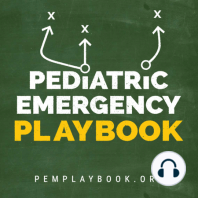37 min listen
Strep Throat
ratings:
Length:
41 minutes
Released:
Aug 1, 2018
Format:
Podcast episode
Description
Does Your Patient Have Streptococcal Pharyngitis? No Problem -- I'll just Swab. Not So Fast... Fagan Nomogram for Likelihood Ratios 1. Decide on your pre-test probability of the disease (choose an approximate probability based on our assessment) 2. Use the likelihood ratio that correlates to your exam. 3. Draw a straight line frm your pre-test probability starting point, to the LR of the feauture/test, take it through to find your post-test probability 4. Use this new post-test probability to help in your decision Your patient has palatal petechiae, which confers a positive likelihood ratio (LR+) of 2.7 See below how to use this statistic based on your clinical assessment" Low Probability Moderate Probability High Probability List of Likelihood Ratios for Streptococcal Pharyngitis Symptoms and signs Positive LR (95% CI) Negative LR (95% CI) Sensitivity (95% CI) Specificity (95% CI) Scarlatiniform rash 3.91 (2.00-7.62) 0.94 (0.90-0.97) 0.08 (0.05-0.14) 0.98 (0.95-0.99) Palatal petechiae 2.69 (1.92-3.77) 0.90 (0.86-0.94) 0.15 (0.10-0.21) 0.95 (0.91-0.97) Chills 2.16 (0.94-4.96) 0.88 (0.79-0.98) 0.21 (0.18-0.24) 0.90 (0.83-0.97) Anorexia 1.98 (0.83-4.75) 0.53 (0.26-1.10) 0.62 (0.12-1.11) 0.62 (0.12-1.12) Pharyngeal exudate 1.85 (1.58-2.16) 0.78 (0.74-0.82) 0.38 (0.32-0.44) 0.79 (0.73-0.84) Vomiting 1.79 (1.56-2.06) 0.85 (0.81-0.90) 0.28 (0.21-0.36) 0.84 (0.79-0.89) Tender cervical nodes 1.72 (1.54-1.93) 0.78 (0.75-0.81) 0.40 (0.35-0.46) 0.77 (0.71-0.82) Sibling with sore throat 1.71 (0.82-3.53) 0.92 (0.82-1.03) 0.18 (0.14-0.23) 0.89 (0.83-0.94) Halitosis 1.54 (0.79-2.99) 0.95 (0.81-1.12) 0.12 (0.05-0.29) 0.92 (0.86-0.99) Tonsillar and/or pharyngeal exudate 1.40 (1.10-1.77) 0.86 (0.75-0.98) 0.37 (0.28-0.46) 0.74 (0.68-0.78) Large cervical nodes 1.39 (1.16-1.67) 0.67 (0.53-0.84) 0.64 (0.50-0.76) 0.54 (0.41-0.67) Lack of cough 1.36 (1.18-1.56) 0.59 (0.48-0.73) 0.73 (0.66-0.78) 0.46 (0.38-0.55) Tonsillar exudates 1.35 (0.98-1.87) 0.81 (0.63-1.06) 0.46 (0.27-0.67) 0.66 (0.48-0.80) Tonsillar swelling 1.27 (1.04-1.54) 0.67 (0.52-0.85) 0.70 (0.64-0.76) 0.44 (0.32-0.57) Dysphagia 1.22 (1.00-1.48) 0.68 (0.51-0.91) 0.72 (0.55-0.85) 0.41 (0.23-0.62) Headache 1.22 (0.95-1.57) 0.90 (0.77-1.04) 0.39 (0.28-0.51) 0.68 (0.58-0.76) Lack of coryza 1.21 (1.08-1.35) 0.69 (0.55-0.88) 0.72 (0.64-0.79) 0.40 (0.34-0.48) Abdominal pain 1.18 (0.92-1.51) 0.95 (0.89-1.03) 0.24 (0.19-0.30) 0.79 (0.75-0.83) Red tonsils and/or pharynx 1.13 (0.96-1.33) 0.41 (0.16-1.02) 0.93 (0.85-0.96) 0.18 (0.09-0.35) Reported fever 1.07 (0.96-1.19) 0.86 (0.67-1.11) 0.71 (0.58-0.82) 0.33 (0.23-0.49) Red tonsils 1.07 (0.86-1.34) 0.82 (0.40-1.69) 0.80 (0.60-1.00) 0.25 (0.00-0.51) Red pharynx 1.06 (0.95-1.18) 0.56 (0.27-1.17) 0.93 (0.81-0.98) 0.12 (0.03-0.34) Documented temperature >38° or >38.5°C 1.02 (0.87-1.21) 0.98 (0.83-1.15) 0.50 (0.36-0.63) 0.51 (0.38-0.65) Summer 0.86 (0.61-1.20) 1.02 (1.00-1.05) 0.13 (0.00-0.33) 0.85 (0.65-1.04) Arthralgia 0.74 (0.18-3.08) 1.02 (0.97-1.06) 0.09 (0.00-0.25) 0.90 (0.77-1.04) Conjunctivitis 0.73 (0.46-1.16) 1.02 (0.98-1.05) 0.05 (0.02-0.11) 0.94 (0.85-0.98) Acute otitis media 0.65 (0.14-2.91) 1.04 (0.93-1.16) 0.03 (0.01-0.05) 0.94 (0.84-1.04) History of tonsillectomy 0.64 (0.49-0.84) 1.07 (1.03-1.11) 0.11 (0.08-0.13) 0.84 (0.81-0.86) Hoarseness 0.62 (0.46-0.83) 1.04 (1.03-1.06) 0.06 (0.03-0.12) 0.90 (0.85-0.93) Diarrhea 0.51 (0.33-0.79) 1.04 (0.99-1.11) 0.03 (0.00-0.06) 0.93 (0.86 Modified from: Shaikh et al. 2012 This post and podcast are dedicated to Sarah Werner for her constant encouragement of the story in all of us. Check out Write Now with Sarah Werner. Sel
Released:
Aug 1, 2018
Format:
Podcast episode
Titles in the series (100)
Altered Mental Status in Children: How do you approach the child who may be altered? Altered mental status in children can be subtle. Look for age-specific behaviors that range from irritability to anger to sleepiness to decreased interaction. In the altered child,... by Pediatric Emergency Playbook
